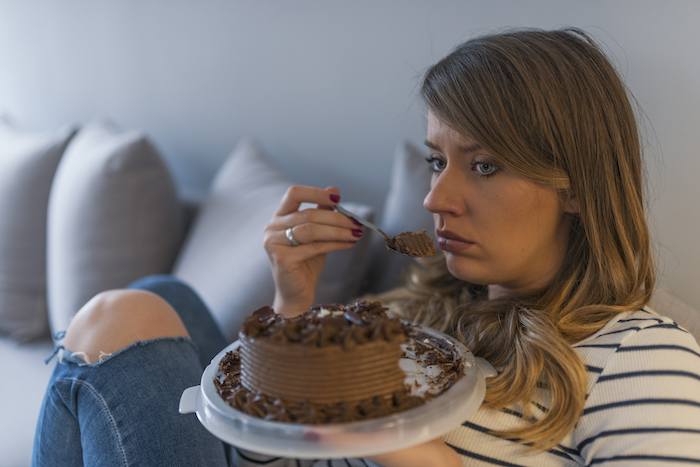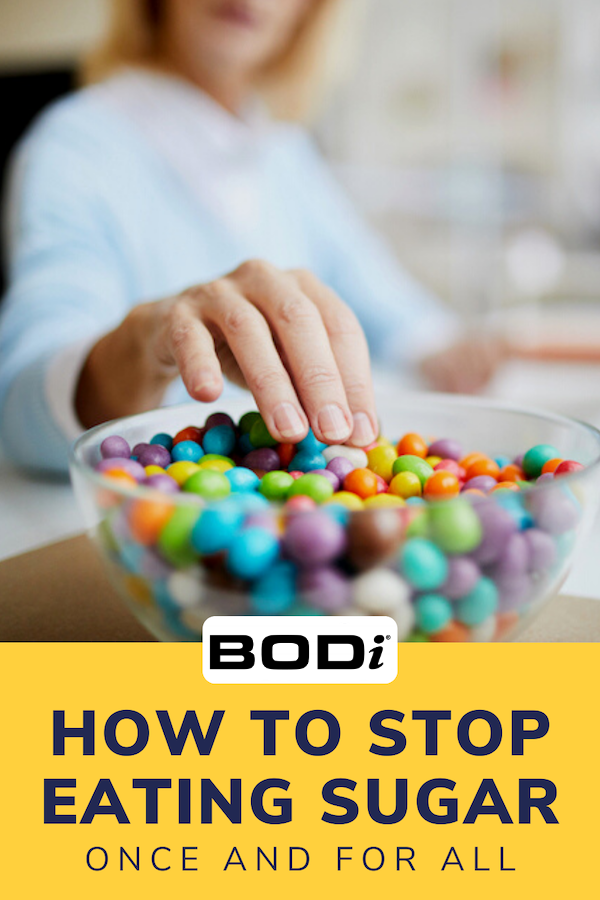Everybody craves sweets every now and then, but how do you know it’s time to get your sugar habit in check? Is it possible to learn how to stop eating sugar? And — most importantly — do you have to break up with sugar completely and forever?
First up, you need to know how to define “sugar.” We’re not talking about the sugar in fruit (or even in milk). When you hear about the risks of sugar, we are talking about “added sugars,” which have been required to be included on nutrition facts labels since in 2020.
“A lot of people think that using honey, agave, coconut sugar, or date sugar in place of white sugar is healthier,” says Stephanie Searor, MS, RD, LDN. “Sugar is sugar. These all still have approximately the same amount of calories, and actually, honey has even more calories per teaspoon than table sugar (21 calories for honey versus 16 calories for table sugar).”
The problem is not enjoying a cupcake now and again or ice cream on a hot summer day. “The problem lies in the day-to-day constant exposure to sugar in processed foods,” says Tina Marinaccio, MS, RD, who offers nutrition counseling and cooking classes in the greater New York City area. “The palate gets used to expecting a cloyingly sweet taste.”
Let’s look at some different methods for how to stop eating sugar, as well as the signs that you might be eating too much.
How Much Added Sugar Is Too Much?
The average American consumes 17 teaspoons (71 grams) of added sugar per day. But, according to the American Heart Association, men should aim to consume no more than nine teaspoons (36 grams) of added sugars, while women should consume no more than six teaspoons (25 grams) from added sugars.
And added sugar hides in plain view, says Dr. Whitney Bowe. “It may be called something other than ‘sugar.’ Cane sugar, sucrose, fructose, agave nectar, high fructose corn syrup — but sugar is sugar, no matter how you spell it. There are more than [70] names for sugar! And it can be hard to avoid if you don’t make a conscious effort and know what to look for.”
How to Stop Eating Added Sugar
It’s up to you to decide when and how to stop eating added sugar (or simply cut back). Searor recommends using the Yale Food Addiction Scale as a first step.
“This can help to determine whether or not you may be experiencing food addiction,” she says.
Your brain releases the feel-good chemical dopamine when you eat sugary foods, Searor adds. So if you feel out of control around chocolate and jelly beans, know that some of us are “hypersensitive to the reward mechanisms of the brain, meaning that eating foods that are high in sugar (or fat or salt) could release way more chemicals in their brains,” she says.
Here’s a look at some of the different ways you can train yourself on how to stop eating sugar.
1. Cutting added sugar cold turkey
While you can completely cut out added sugar overnight, Searor says it’s difficult and hard to be 100 percent successful — you definitely need a plan. “It can be very overwhelming to give anything up cold turkey,” she says. If you plan to cut out sugar entirely, then you need to know what you are going to eat instead.
Marinaccio creates individual meal plans for clients who go cold turkey off added sugar. She helps them incorporate whole fruits, naturally sweet starches like sweet potatoes and butternut squash, beans, and whole grains in place of processed and sugary carbs. This “allows the palate to reset in a short period of time without feeling deprived,” according to Marinaccio.
2. Cutting back on added sugar
Cutting back on added sugar without eliminating it is the easiest habit to implement (but requires willpower). You can decide for yourself what this looks like, but here are a few simple tips and tricks:
- Reduce your fast food intake. (There’s added sugar lurking even in savory foods.)
- Switch from sugar-sweetened soda and other sugar-sweetened drinks to sparkling water. Add a slice of lemon, lime, or cucumber for extra flavor.
- Swap sugary pastries with a piece of fruit. Try apple slices with peanut butter, or nosh on berries.
- Scale back on the sugar in your coffee and tea. Start with one fewer teaspoon until that tastes sweet, then keep cutting back.
- Read labels. Added sugars hide in some canned fruit (look for canned in its own juice), packaged granola bars, and just about every processed food.
- Trade sugary glazes and sauces (like barbecue and teriyaki) for tangy or savory ones like pesto, vinaigrette (with no sugar added), and mustard.
“These are all ways that you can slowly reduce processed food intake and set yourself up for long-term success,” says Searor.
Crowding out sugary and processed foods and replacing them with nutrient-dense whole foods can slowly take away sugar’s power. Eventually, you find that you can take it or leave it.
“If you want to have an ice cream, have an ice cream,” Searor adds. “Just be mindful of it. Know that you are eating it because you want to, not because it’s a reward or as a way to overlook stress.”
How to Come Back from a Sugar “Detox”
Even if you gave up added sugar cold turkey, you can often bring it back into your life without backtracking, says Marinaccio. When you feel ready, treat yourself to a really good cookie, a slice of your favorite cake, or a donut; eat it slowly and observe how you feel.
She says that some of her clients find that sweets have completely lost their power — and their appeal — from this approach, “because either their palate has changed, or some of the allure turned out to be nostalgia, where they associated sweets with a memory, and now it no longer serves them.”
When You Should Seek Professional Help
Does the idea of quitting added sugar give you the cold sweats? If you feel anxious about it, says Searor, you might want to work with a therapist at the same time (or even before) you talk to a registered dietitian about learning techniques for how to stop eating added sugar.
“There are often underlying experiences that have led us to turn to food for comfort,” she explains, adding that with therapy “you can start to develop healthy relationships in all aspects of your life, including your relationship with food.”




